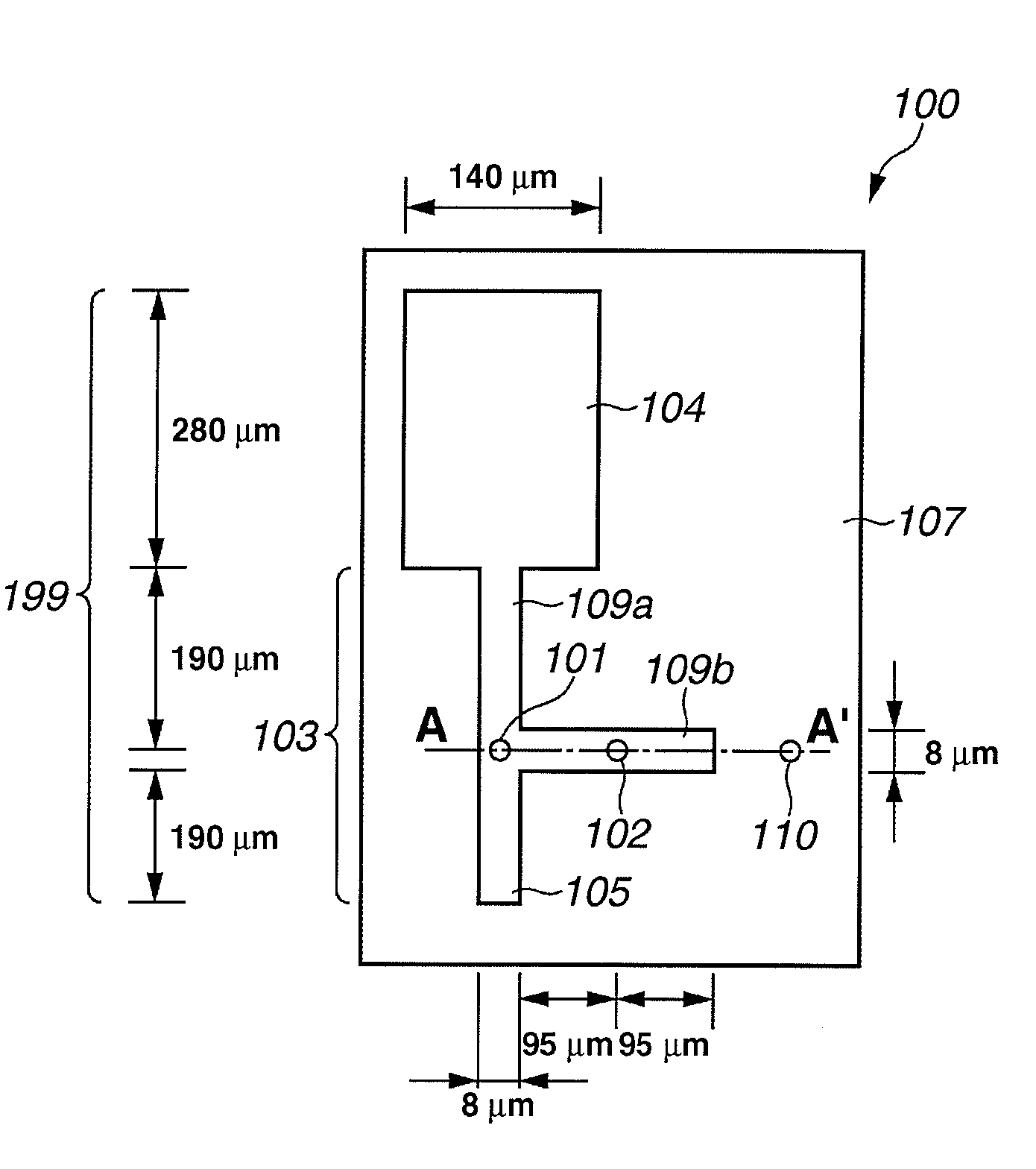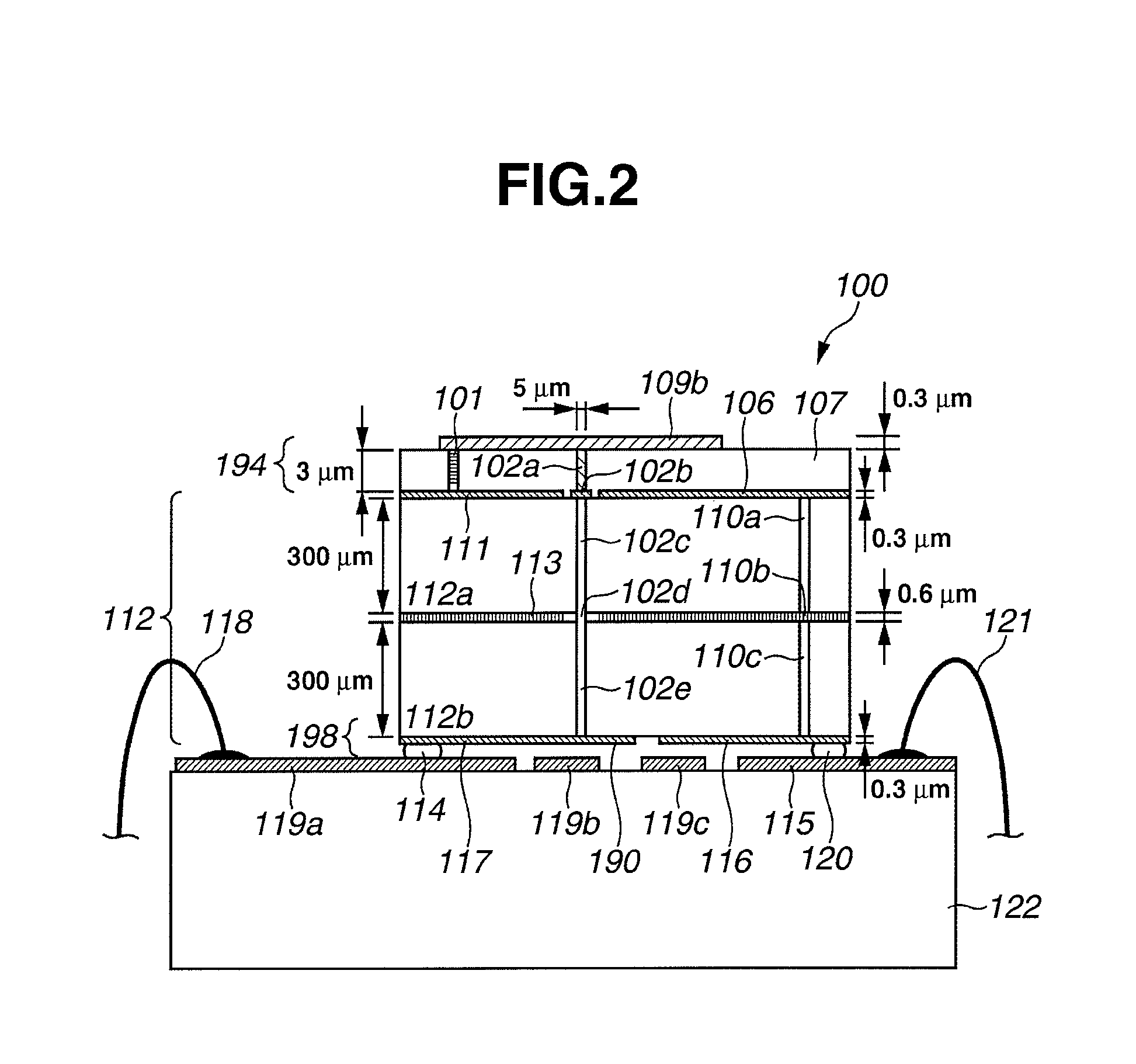Electromagnetic-wave oscillator
a technology of electromagnetic wave and oscillator, which is applied in the direction of oscillator, basic electric elements, pulse technique, etc., can solve the problems of large space occupation of dc supply portion, large apparatus size, and restricted general or industrial use, so as to achieve efficient transmission and increase the flexibility of the design of the emw oscillator on the substrate.
- Summary
- Abstract
- Description
- Claims
- Application Information
AI Technical Summary
Benefits of technology
Problems solved by technology
Method used
Image
Examples
first embodiment
[0033]Features and operation of the oscillator 100 of the first embodiment will be described. When the DC signal is supplied to the RTD 101, induced emission of an electromagnetic wave occurs in the RTD 101. The wavelength of the electromagnetic wave is an approximately single oscillation wavelength λ (λ: the wavelength in vacuum) is a range of the THz wave, that is acquired due to the negative resistance of the RTD 101. The emitted electromagnetic wave is an electromagnetic wave with an effective wavelength λg (λg: the wavelength in the dielectric portion 107) in the dielectric portion 107, and propagates in an MSL patch antenna 199. The MSL patch antenna 199 includes the MSL resonator 103, the antenna 104, the GND portion 111, the dielectric portion 107, the RTD 101, and the like. The propagating electromagnetic wave resonates as a standing wave, and is amplified in the MSL patch antenna 199.
[0034]Under some conditions, an electromagnetic wave with the oscillation wavelength is os...
second embodiment
[0072]As described above, in the second embodiment, electromagnetic waves at low frequencies less than the cutoff frequency can be intercepted by the waveguide with a cavity in the penetrating electrode, and the low frequency noise from the DC power source can be reduced, leading to improvement of the oscillation characteristic. It is also possible to enhance the shielding effect by loading the above cavity of the waveguide with resin, or the like.
[0073]Next, details of an oscillator of a third embodiment will be described referring to FIGS. 5, 6A and 6B. FIG. 5 is a cross-sectional view illustrating the third embodiment, in which a lens substrate 501 with a curve such as a semi-sphere or an ellipsoid is placed on the oscillator. FIGS. 6A and 6B are plan views illustrating oscillators with lens structures of two types, respectively. Specific sizes of the lens substrate 501 are indicated in FIG. 5 (not to scale). Illustration and description of portions of the third embodiment simila...
third embodiment
[0075]In the third embodiment, the lens substrate 501 is formed of resin of cycloolefin group that has a relatively small dielectric loss for a THz wave, and an excellent processing capability. The lens substrate 501 is produced by molding technique using a conventional metal mold for fine process machining. A material with a small loss for the THz wave is preferable as the lens material that is selected in the light of the lens profile and the processing capability. Inorganic materials, such as silicon, ceramics, and glass, organic materials, such as polyethylene and Teflon (trade mark), and the like can also be used.
[0076]The lens substrate 501 is connected to the oscillator 100 through a spacer 502. In this embodiment, the spacer 502 is a double-stick adhesive tape made of polyethylene telephthalate (PET) that has a high processing capability, and is 100 microns in thickness. After the substrate of the oscillator 100 and the lens substrate 501 are aligned to the spacer 502, they ...
PUM
 Login to View More
Login to View More Abstract
Description
Claims
Application Information
 Login to View More
Login to View More - R&D
- Intellectual Property
- Life Sciences
- Materials
- Tech Scout
- Unparalleled Data Quality
- Higher Quality Content
- 60% Fewer Hallucinations
Browse by: Latest US Patents, China's latest patents, Technical Efficacy Thesaurus, Application Domain, Technology Topic, Popular Technical Reports.
© 2025 PatSnap. All rights reserved.Legal|Privacy policy|Modern Slavery Act Transparency Statement|Sitemap|About US| Contact US: help@patsnap.com



